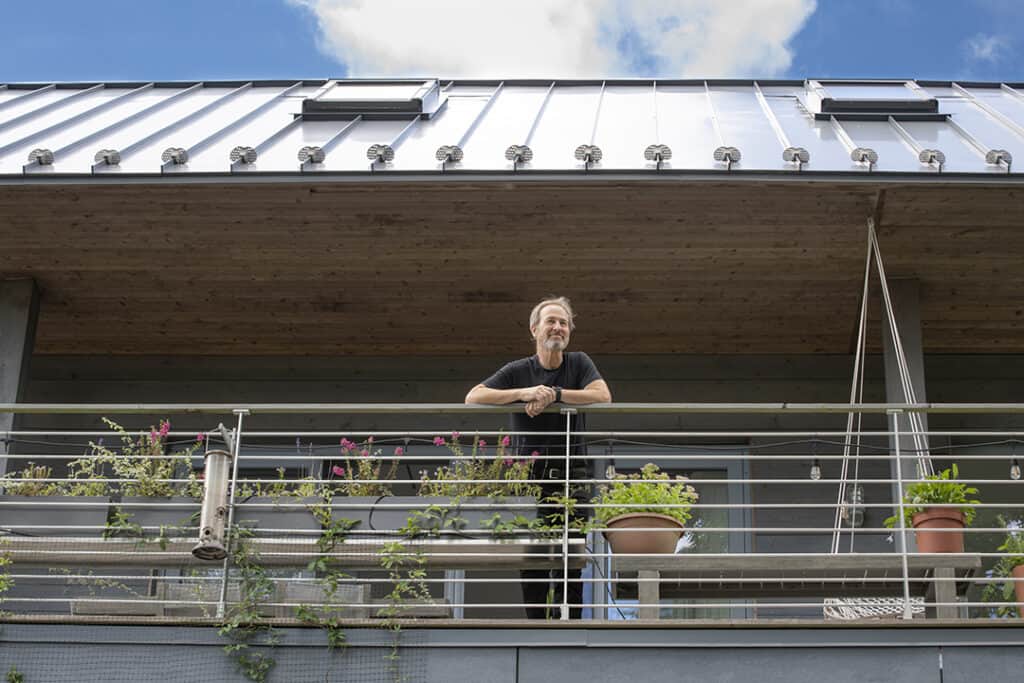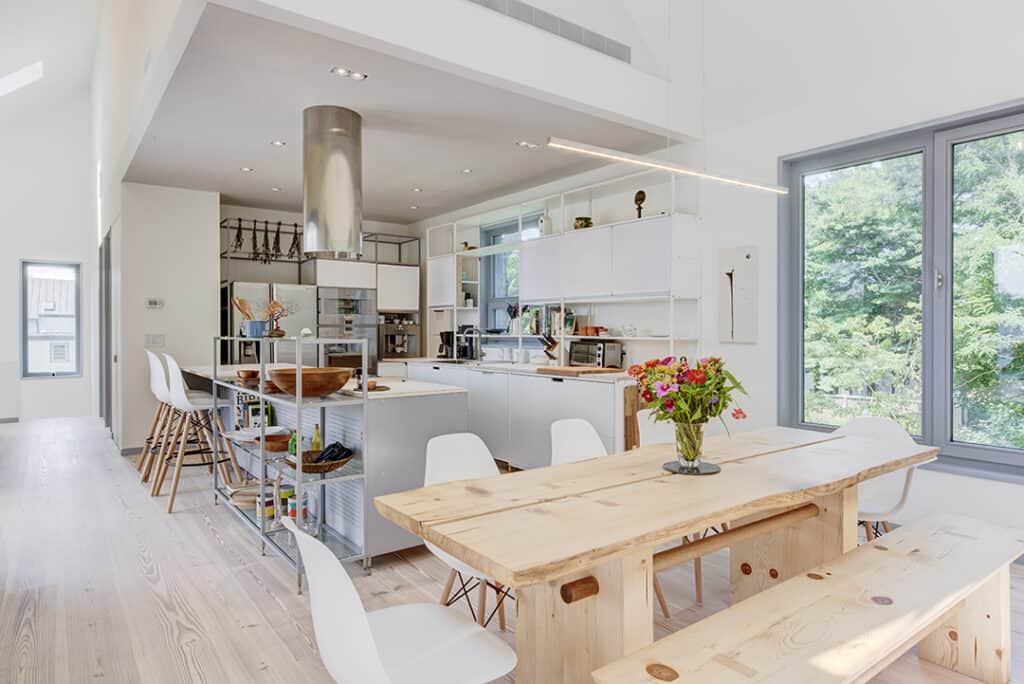Top 5 Tips for Creating a More Sustainable Kitchen
The kitchen is often said to be the heart and hub of the home. With an observed uptick in kitchen remodel spending and consumer interest in leading a more environmentally-friendly lifestyle, it’s clear that sustainable kitchen design is becoming a major priority for many.

Having recently designed his own all-electric kitchen and home to Passive House standards, architect Wayne Turett, founder and principal of the NYC-based, award-winning firm The Turett Collaborative, shares his five key starting points for creating a more eco-friendly kitchen.
“More informed choices and steps in the right direction can all contribute to a more sustainable world,” notes Turett. “Whether you are building new or renovating, energy-efficiency and indoor air-quality are key factors to consider.”

1. Do Your Homework on ENERGY STAR® Appliances + Lighting
Most kitchen appliances will fit within the ENERGY STAR® category of saving electricity. But if you want to substantially reduce your energy consumption (and really save on the power bill), you will need to research how much each appliance costs to run and compare that with its competitors. Additionally, LED lights tend to use a lot less electricity. Using dimmers, light wall paint, task lighting, and lamps instead of overhead lights can also save energy.
2. Goodbye Gas, Hello Induction Cooking
Though gas cooking is often touted as the superior cooking method, it can have significantly harmful health implications due to indoor air pollution, according to the WHO and a recent Stanford Study. Cooking with induction, however, is much less risky and more energy-efficient. In addition to quick heating and boiling properties, induction cooktops are easy to clean and provide additional counter space when not in use. But no matter what type of stove or cooktop you have, proper ventilation and a hood vented to the exterior is key to extracting polluted air from your home.
3. Don’t Take Your Countertops for Granite
Provided it’s easy to mine and sourced locally, on-trend stone countertops are fairly sustainable options due to the material’s longevity. If opting for quartz, look for Greenguard-certified quartz or quartz made from recycled content. Not always thought of as a sought-after material, durable, easy to clean and reliable laminate countertops like the one used in Turett’s own Passive House from Abet Laminati can be both a cost-saving and an environmentally-friendly option.
4. Mind the Glue on Your New Cabinets
For cabinets, a great material option is a wood-based substrate called MDF. However, MDFs can often be accompanied by formaldehyde glue, so it’s important to look for MDFs with no added formaldehyde (NAF).
5. Buy Local & Consider Longevity + Repurposing
Opt for locally-sourced materials when you can – using your location as a key deciding factor. It’s also incredibly important to consider the quality of your materials. In order to make the most sustainable choice, you want to choose long-lasting materials that will stay in your home and out of landfills.












!['The Maples' is a prestigious generational compound of two extraordinary estates: 18 Maple and 22 Maple. This rare offering, designed by luxury architect Lissoni partners New York and developed by visionaries Alessandro Zampedri-CFF Real Estate and JK Living, redefines opulence with the highest quality of craftsmanship and captivating views of the Atlantic Ocean. Represented by @nycsilversurfer and @challahbackgirl of @douglaselliman. [link in bio]](https://hamptonsrealestateshowcase.com/wp-content/uploads/sb-instagram-feed-images/438891010_1083749139481747_7890082604579275354_nfull.jpg)
![Featuring 360-degree water views on Mecox Bay, the Atlantic Ocean and Channel Pond, 1025 Flying Point offers the ultimate beach cottage that is flooded with natural light. With panoramic views, proximity to the ocean, and a private walkway to Mecox bay for kayaking or paddle boarding, this truly is a special retreat. Represented by @ritcheyhowe.realestate and @hollyhodderhamptons of @sothebysrealty. [link in bio]](https://hamptonsrealestateshowcase.com/wp-content/uploads/sb-instagram-feed-images/438994305_737511778456166_4602476013493875279_nfull.jpg)
![Attention advertisers! 📣 Secure your spot in the highly anticipated Memorial Day edition #HRES. Reach thousands of potential clients and showcase your brand in one of the most sought-after publications in the Hamptons, NYC, Palm Beach, and beyond. Contact us now to reserve your ad space! [link in bio]](https://hamptonsrealestateshowcase.com/wp-content/uploads/sb-instagram-feed-images/438549843_275102939023235_6718257301437562124_nfull.jpg)
![You eat with your eyes, and on the East End, it’s important that what you eat looks just as good as how it tastes. At @rosies.amagansett, the restaurant itself is plenty photo-worthy with blue ceramic tiling and yellow and white striped fabric wallpaper. But for a dish that will light up your photos, head directly to the salmon tartare! [link in bio]](https://hamptonsrealestateshowcase.com/wp-content/uploads/sb-instagram-feed-images/437094269_7296727147115953_1594410326824303644_nfull.jpg)

![We were honored to be the media sponsor for @blackmountaincapital's open house event with @jameskpeyton and @jfrangeskos at 11 Dering Lane in East Hampton! Other sponsors included @landrover, Feline Vodka, @rustikcakestudio, @la_parmigiana, @lahaciendamexicangrill11968, @homesteadwindows, Stone Castle, @talobuilders, and @thecorcorangroup.
A big thank you Carrie Brudner of Black Mountain Capital for putting together this fabulous event! [link in bio]](https://hamptonsrealestateshowcase.com/wp-content/uploads/sb-instagram-feed-images/437081213_762912965932136_6847332836522786568_nfull.jpg)

![Blooms Galore at the Long Island Tulip Festival! 🌷✨ Mark your calendars for April 15th as the vibrant tulips at @waterdrinkerlongisland burst into full bloom! Enjoy a day filled with colorful splendor, food trucks, live music, and more. [link in bio]](https://hamptonsrealestateshowcase.com/wp-content/uploads/sb-instagram-feed-images/437083429_974242677583725_6855805712693638343_nfull.jpg)
